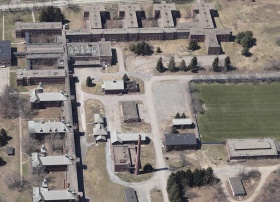Difference between revisions of "Pavilion Plan Institutions"
(Created page with 'Pavilion became a term of hospital architecture in the mid nineteenth century. It means a detached or semi-detached block or building in a hospital complex. The PAPHE glossary de…') |
|||
| Line 51: | Line 51: | ||
The Manor Certified Institution (at Epsom for London CC) was a large structure consisting of temporary pavilions arranged around an L- shaped corridor, with a pre-existing mansion as its hub and offices. Darenth Park 2nd Annexe consisted of two groups of five y-shaped pavilions linked by corridors. (Andrew Roberts) | The Manor Certified Institution (at Epsom for London CC) was a large structure consisting of temporary pavilions arranged around an L- shaped corridor, with a pre-existing mansion as its hub and offices. Darenth Park 2nd Annexe consisted of two groups of five y-shaped pavilions linked by corridors. (Andrew Roberts) | ||
| + | <center> | ||
| + | {| | ||
| + | | [[File:The Manor Hospital UK.jpg|thumb|280px|[[The Manor Hospital]]]] | ||
| + | |} | ||
| + | </center> | ||
| − | + | ||
| + | [[Category:United Kingdom Congregate Style]] | ||
Revision as of 09:54, 6 March 2010
Pavilion became a term of hospital architecture in the mid nineteenth century. It means a detached or semi-detached block or building in a hospital complex. The PAPHE glossary defines a pavilion as "a building or a main building with a block plan". However, PAPHE uses the term "Pavilion Hospital" in an extended sense for "an edifice consisting of independent buildings (completely isolated or linked to each other through open galleries), irrespective of the layout".
The first Pavilion type hospital was the Royal Herbert, on Shooters Hill Eltham, a military hospital opened on Jan 11, 1865. The second was St. Thomas' in London, which opened in 1871. These were designed on principles recommended by Florence Nightingale. The Architect of Royal Herbert being her nephew. Therefore all pavilion and corridor-pavilion types should post-date these
Contents
Standard Pavilion
From 1870 to 1907, is a hugely widespread type, and essentially the first common hospital plan and greatly advocated by Florence Nightingale, but little used within asylum design. The principles of it seem to have been utilized in the echelon plan. The standard pavilion usually consisting of a long linear corridor with individual ward blocks to allow free passage of air and light. Central admin block. Hall and services could be central or remote. Eg. Hellesdon (Norwich), Darenth Park (MAB)(original block and first annex)
Corridor Pavilion
From about 1870 to 1890, is an ill-defined group of buildings intermediate in character between the two types. Thanks to its vague definition, I cannot really seem to identify many to this layout. Possibly used at St. John's and St. Lukes (on a radial corridor) divisions at Whittingham (Lancs), De La Pole (Hull). The first and last show a courtyard type plan with wards facing into this area.
Dual Pavilion
Axial services and facilities flanked on either side by long corridors with individual blocks. The sheer size of these complexes blocks made them operationally difficult and they were initially intended as somewhere to segregate incurables and chronic cases away from other patients. Typified by the huge Caterham (deep well) and Leavesden Imbecile Asylums of 1870 for the Metropolitain Asylums Board of London (which used the pavilion plan in nearly all of its hospital buildings). Banstead 1877 (for Middlesex) and Possibly Winwick (1897) may have been the only non-imbecile examples. Calderstones Certified Institution 1905 (Lancashire Asylum Board) is a late example.
Radial Pavilion
An oddity, and intermediate between the standard pavilion and the development towards the echeon plan. Individual ward blocks arranged around a semi circular corridor with axial office and service accommodation. Cane Hill (Surrey 1883 - water tower) is the only true example but could include Whittingham's St. Luke's Block (which had remote services) in some respects.
Irregular Pavilion
The Manor Certified Institution (at Epsom for London CC) was a large structure consisting of temporary pavilions arranged around an L- shaped corridor, with a pre-existing mansion as its hub and offices. Darenth Park 2nd Annexe consisted of two groups of five y-shaped pavilions linked by corridors. (Andrew Roberts)








